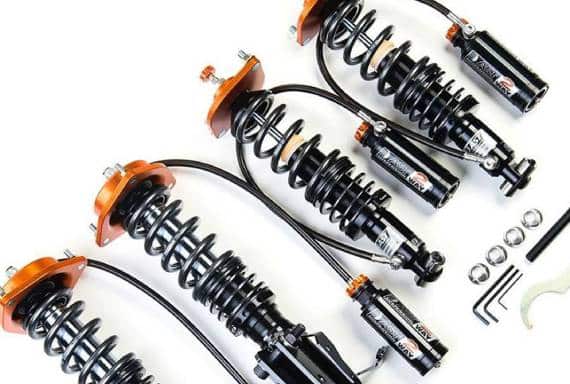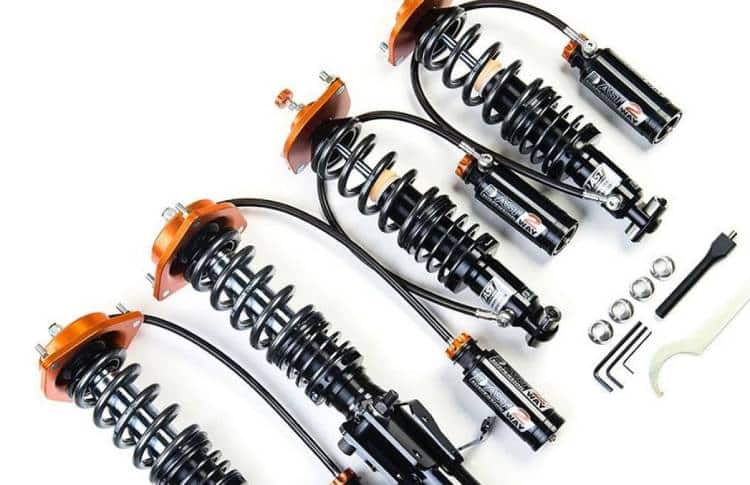Spring rate conversion calculates the change from one measurement unit to another. It’s essential for understanding suspension characteristics.
Navigating the world of vehicle suspensions demands a grasp of several technical specifications, one of which is the spring rate. The spring rate defines the stiffness of a spring and dictates how a vehicle responds to various road conditions. For automotive enthusiasts, mechanics, and engineers, spring rate conversion is a critical skill because it allows them to adapt and compare springs across different unit systems, such as converting from pounds per inch to Newtons per millimeter.
This knowledge ensures the optimal selection and modification of suspension components for improved handling and comfort. Understanding and performing these conversions accurately is integral for ensuring vehicle performance and safety, making it a fundamental aspect of automotive suspension tuning and design.
Introduction To Spring Rate Conversion
Introduction to Spring Rate Conversion: Understanding the mechanics behind vehicle suspension involves delving into the world of spring rates. Spring rate conversion plays a pivotal role in the performance and comfort of a vehicle. With different measurement units used worldwide, accurately converting spring rates ensures suspension systems function at their best.
The Importance Of Correct Spring Rate In Suspension Systems
A vehicle’s suspension is its lifeline on the road. The spring rate is critical in determining how well a suspension will perform. It impacts:
- Ride Comfort: A smooth and comfortable ride depends on the right spring stiffness.
- Handling: Precise handling relies on having a balanced spring rate.
- Vehicle Stability: Stability during motion is a must for safety reasons; this too hinges on the correct spring rate.
- Weight Support: The spring rate determines the capacity to support vehicle weight effectively.
Basics Of Spring Rate Units
The unit of measurement for spring rate varies depending on the region or industry standards. There are primarily two units:
| Unit | Description |
|---|---|
| Pounds per inch (lb/in) | Commonly used in the United States |
| Newtons per millimeter (N/mm) | Widely used internationally and in scientific circles |
Converting between these units requires precise calculation to maintain suspension integrity.

Credit: www.drifted.com
Common Spring Rate Measurements
Understanding spring rate measurements is crucial for selecting the right spring for your needs. Whether you’re working on a vehicle, machinery, or any application where springs are essential, knowing how to convert and compare these measurements ensures you get the perfect match. This guide dives into the common spring rate measurements, ensuring a smooth translation between metric and imperial units.
Metric Versus Imperial Units
When dealing with spring rates, two main units of measurement come into play: metric and imperial. These systems vary significantly, impacting how we interpret and apply the specifications for spring performance.
| Metric System | Imperial System |
|---|---|
| Kilograms per millimeter (kg/mm) | Pounds per inch (lb/in) |
Understanding Pounds Per Inch (lb/in)
The lb/in measurement indicates how many pounds a spring can support over one inch of compression. This unit is prevalent in the United States and serves as a standard for many industries.
- Used in automotive and mechanical engineering.
- Determines the stiffness of a spring.
- Higher lb/in values mean a stiffer spring.
Kilograms Per Millimeter (kg/mm) Explained
Conversely, kg/mm is a metric unit used globally except in the USA. It shows the force in kilograms needed to compress the spring by one millimeter.
- Standard for many international applications.
- Reflects spring rate in metric terms.
- A higher kg/mm signifies increased stiffness.
Converting between lb/in and kg/mm is straightforward with the right formula. Use this to ensure your spring’s specifications meet the project’s requirements, no matter the measurement system.
Step-by-step Conversion Process
Spring rate conversion is essential for car enthusiasts and engineers alike. You’ll need to convert spring rates into your desired units to ensure your vehicle has the perfect bounce. This can be done in pounds per inch (lb/in) or newtons per millimeter (N/mm), among others. Let’s look at how to achieve this through a simple process.
Calculating The Conversion Factor
A conversion factor is a number used to change one set of units to another, by multiplying or dividing. Here’s how to work it out:
- Determine your target unit of measurement.
- Find the correct conversion factor. For instance, 1 lb/in equals 0.175127 N/mm.
- Write this number down as it’s your key to conversion.
Manual Conversion Technique
Converting spring rates manually is straightforward but requires attention. Here’s what to do:
- Start with your current spring rate value.
- Multiply this number by the conversion factor.
- The result is your converted spring rate.
For example, to convert 200 lb/in to N/mm:
200 lb/in x 0.175127 N/mm = 35.0254 N/mm
Using Online Calculators And Apps
Manual conversion is easy, yet online tools can simplify the process even further:
- Input your spring rate into the calculator.
- Select your current and desired units.
- Press calculate to see instant results.
These tools often offer more complex conversions and are regularly updated for accuracy. Choose one recommended by automotive professionals.
Real-world Applications
Understanding spring rate conversion is crucial in various real-world scenarios.
It shapes how vehicles perform and ride. This section explores its impact, with a focus on automotive applications.
Adjusting Spring Rate For Vehicle Performance
Optimizing spring rate is vital for vehicle design and customization.
A well-calculated spring rate ensures peak performance.
- Racing cars need stiffer springs to minimize body roll during sharp turns.
- Off-road vehicles benefit from a balanced spring rate to handle rough terrains.
- Heavy-duty trucks require springs that support heavy loads without sagging.
Converting and adjusting spring rates allows for precise tuning. This tuning matches specific vehicle needs and driver preferences.
Impact On Ride Comfort And Handling
Spring rate directly affects comfort and handling. It’s a balancing act between a soft and stiff ride.
Low spring rates result in a smoother ride, perfect for regular driving conditions.
On the other hand, high spring rates offer better vehicle stability.
This stability is ideal for performance-focused driving.
| Spring Rate | Ride Quality | Handling |
|---|---|---|
| Low | Comfortable | Softer |
| High | Firmer | Stable |
Tuning spring rates is a critical process in vehicle setup. It ensures an optimal experience for drivers.
Both safety and driving pleasure rely on it.
Advanced Topics In Suspension Tuning
Exploring the nuances of suspension tuning elevates a vehicle’s performance.
Precision and expertise lead to mastery over tough terrains and race tracks alike.
Advanced techniques entail a deep dive into the marriage of springs and dampers.
This affects handling, comfort, and control.
Let’s dissect key elements for enthusiasts aiming to perfect their suspension setup.
Fine-tuning With Variable Rate Springs
Variable rate springs are a game-changer.
They offer versatility and adaptability on-the-fly.
Traditional linear springs can’t match this.
Your ride needs to handle different stresses while driving.
Variable rate springs step up to this challenge.
- Improved comfort during regular driving conditions
- Enhanced stability when cornering or dealing with heavy loads
- Various options for fine-tuning without replacements
Use them to tailor your vehicle’s response to changing dynamics.
This guides performance seamlessly.
The Role Of Damping In Conjunction With Spring Rate
Damping matters.
It’s the unsung hero working with spring rate.
Think of springs as muscles and dampers as reflexes.
Both need to sync for optimal performance.
Damping controls how springs compress and rebound.
It keeps the tires grounded.
It also reduces excessive movements, balance, and body roll.
| Spring Rate | Low Damping | High Damping |
|---|---|---|
| Soft | Bouncy Ride | Controlled, but Slack |
| Stiff | Harsh, Unstable | Controlled, Firm |
Matching damping levels to spring rates is critical.
This ensures a ride that’s both graceful and agile.
Precision tuning lets you conquer sharp turns and bumpy roads alike.
Common Pitfalls And Troubleshooting
Understanding spring rate conversion requires precision. Certain mistakes can lead to incorrect load and spring deflection results. Knowing these errors and how to correct them is crucial for effective troubleshooting. Keep reading for common issues and their solutions.
Mistakes To Avoid During Conversion
Watch out for these conversion blunders:
- Mixing units: Consistency in units prevents conversion errors.
- Math mistakes: Double-check calculations for accuracy.
- Ignoring material properties: Material-specific rates vary greatly.
Use tools like conversion charts and calculators to avoid these mistakes.
Tips For Accurate Spring Rate Selection
Accurate selection is vital for optimal performance:
- Understand the application: Know the load and environment.
- Material matters: Choose the right material for the job.
- Consult charts: Use established reference materials.
- Test springs: Conduct trials to validate the rate.
Implement these tips to ensure you select the correct spring rate for any application.
Frequently Asked Questions Of Spring Rate Conversion
How To Calculate The Spring Rate?
Calculate the spring rate by dividing the force exerted on the spring by the spring’s displacement. Use the formula: spring rate (k) = force (F) / displacement (x).
What Does 10k Spring Rate Mean?
A 10k spring rate indicates that the spring requires 10,000 pounds of force per inch to compress. This measurement is vital for vehicle suspension systems, affecting handling and comfort.
What Is A 5k Spring Rate?
A 5k spring rate refers to a spring that requires 5,000 pounds of force to compress it by one inch. This measurement is crucial for tuning a vehicle’s suspension system for performance and handling.
What Is An 8k Spring Rate?
An 8K spring rate indicates the spring requires 8,000 pounds of force to compress it one inch. It’s a measure of stiffness used in vehicle suspension systems.
What Is Spring Rate Conversion?
Spring rate conversion is the process of translating the stiffness of a spring from one unit of measure to another, usually from pounds per inch (lbf/in) to Newtons per millimeter (N/mm), or vice versa.
Why Is Spring Rate Important?
Spring rate determines the support and comfort level of a vehicle’s suspension or any system using springs, impacting performance and ride quality.
How Do I Calculate Spring Rate?
To calculate the spring rate, divide the force applied to the spring by the displacement caused by that force (Spring Rate = Force ÷ Displacement).
Conclusion
Understanding the nuances of spring rate conversion is key for any project involving suspension tuning. By mastering this, you ensure optimal performance for your vehicle or machinery. Remember, calculating spring rates can be straightforward with the right tools and knowledge.
Keep this guide handy for future reference, and confidently tackle your next conversion.

Steven is a professional cyclist and his passion is cycling. He has been cycling for the last 6 years and he loves using bikes while outing as well. Based on his experiences with the different types of bikes; he is sharing his opinions about various bikes so that a beginner can start right away. Find him on Twitter @thecyclistguy Happy Biking.


Leave a Reply